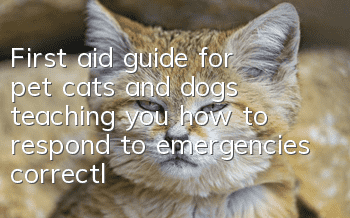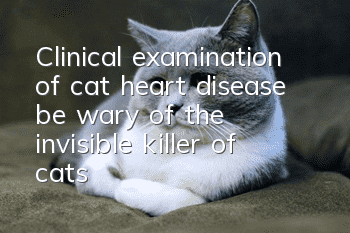First aid guide for pet cats and dogs, teaching you how to respond to emergencies correctly!

Every pet owner hopes that his or her pet can live a healthy and happy life, but unpredictable accidents always happen when we are unprepared. In the face of sudden illnesses and accidents in pets, correct first aid measures can help us protect the lives of pets. Next, we will introduce you to the basic knowledge and response methods of first aid when your beloved pet encounters an idiopathic situation.
Pets are breathing quickly or suffocating
If your pet is short of breath or choking, check your pet's mouth and throat immediately to see if there is anything blocking its airway. If there is a foreign object, you can try to remove it gently with your hands or pliers. If your pet is still unable to breathe, take it to the nearest pet hospital or emergency rescue center immediately.
Pets faint or coma
If your pet faints or is unconscious, the first step is to remain calm. Check your pet's breathing, pulse and temperature, and place him or her in a quiet, comfortable place. If your pet is not breathing or has a heartbeat, perform CPR immediately and transport it to a pet hospital as soon as possible. The specific methods are as follows:
First check whether the pet is breathing and having a heartbeat. If not, CPR needs to be started immediately. Place your pet on a hard surface and carefully inspect it for any unusual conditions. There may be vomitus, secretions, or other obstructions in the mouth and nose that need to be removed. Make sure the airway is clear, then check for a heartbeat. The place to check for heartbeat is on the inside of your pet's forearm, sometimes with a stethoscope.
If your pet has no heartbeat, CPR needs to be started. First, compress the pet's chest 30 times, with the depth of each compression being 1/3-1/2 chest width; then perform 2 mouth-to-mouth or mouth-to-nose artificial respirations, paying attention to the amount and frequency of breathing. During CPR, towels or other soft materials can be used to immobilize the pet's body and head to prevent them from further injury during the rescue. CPR for pets should last about 20 minutes. If the pet has not recovered its heartbeat and breathing, it needs to be sent to the pet hospital for further treatment as soon as possible.
(It should be noted that CPR is only used in emergencies and is best performed by professionals. Therefore, in normal times, try to ensure the health of pets and prevent diseases and accidents.)
Pet fractures or injuries
If your pet has a broken bone or trauma, move it to a safe place as quickly as possible and check it for signs of bleeding or broken bones. When treating a broken bone, be sure to move your pet gently to avoid further damage. Use a bandage or other soft material to fix the injured part, and send it to the pet hospital for further treatment in time.
Pet poisoning
If you suspect your pet has been poisoned, take it to a pet hospital immediately. During transport to the hospital, you can try to clean your pet's mouth and skin with water to reduce the impact of poisons. If you know the cause of your pet's poisoning, you can tell your doctor so that you can receive appropriate treatment.
The following are some common symptoms of pet poisoning:
Nausea, vomiting and diarrhea: This is one of the most common symptoms of pet poisoning and usually occurs within a few hours of the poison entering the pet's body.
Weakness and convulsions: Some poisons can affect the nervous system of pets, causing symptoms such as weakness and convulsions in pets.
Shortness of breath: Certain toxic substances enter the respiratory system of pets, which can cause symptoms such as shortness of breath and difficulty breathing.
Eye, skin and oral irritation: When certain toxic substances enter the body of pets, they can cause irritation and pain in the eyes, skin and mouth.
Fatigue and coma: In some cases, pets may feel fatigued, comatose or even die after being poisoned.
If your pet has the above symptoms, you should take it for emergency treatment immediately. When dealing with pet poisoning in an emergency, it is best to tell the doctor the name, brand, ingredients and intake of toxic substances, so that The doctor takes the correct treatment.
For pet owners, correct first aid measures and response methods can help us protect the lives of pets in emergencies. At the same time, regular health examinations and the development of living habits can also prevent many diseases and accidents!
- What will happen if a cat doesn’t bask in the sun?
- What should I do if my cat has a cold?
- What causes cat ears to bleed?
- What is the function of a cat’s whiskers?
- Choose a lively and active cat based on age, appearance and size
- What's wrong with Garfield cat's stool being a little bloody?
- Will kittens suffer from anal prolapse if they have soft stool?
- Do kittens use cat litter themselves?
- Sequelae of heatstroke in cats
- How to cut pet cat nails



